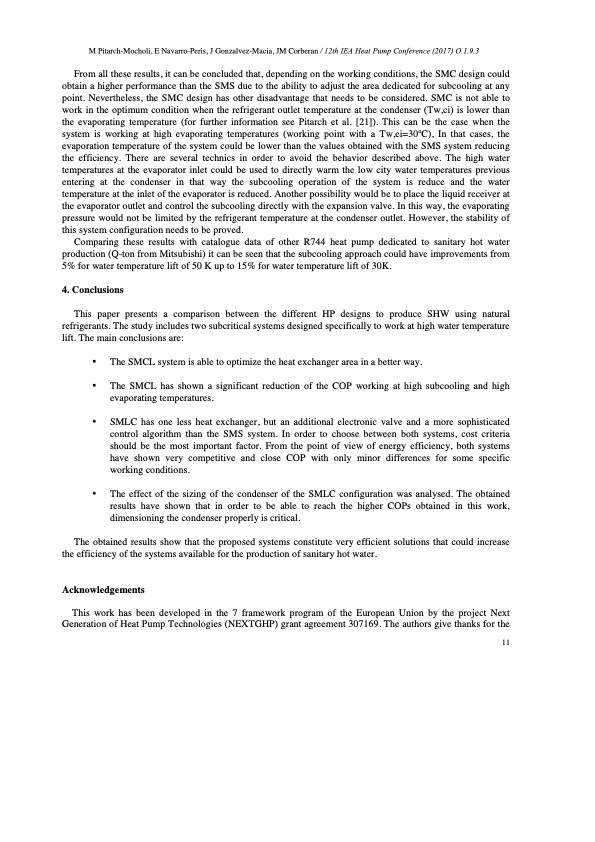
PDF Publication Title:
Text from PDF Page: 011
M Pitarch-Mocholi, E Navarro-Peris, J Gonzalvez-Macia, JM Corberan / 12th IEA Heat Pump Conference (2017) O.1.9.3 From all these results, it can be concluded that, depending on the working conditions, the SMC design could obtain a higher performance than the SMS due to the ability to adjust the area dedicated for subcooling at any point. Nevertheless, the SMC design has other disadvantage that needs to be considered. SMC is not able to work in the optimum condition when the refrigerant outlet temperature at the condenser (Tw,ci) is lower than the evaporating temperature (for further information see Pitarch et al. [21]). This can be the case when the system is working at high evaporating temperatures (working point with a Tw,ei=30oC), In that cases, the evaporation temperature of the system could be lower than the values obtained with the SMS system reducing the efficiency. There are several technics in order to avoid the behavior described above. The high water temperatures at the evaporator inlet could be used to directly warm the low city water temperatures previous entering at the condenser in that way the subcooling operation of the system is reduce and the water temperature at the inlet of the evaporator is reduced. Another possibility would be to place the liquid receiver at the evaporator outlet and control the subcooling directly with the expansion valve. In this way, the evaporating pressure would not be limited by the refrigerant temperature at the condenser outlet. However, the stability of this system configuration needs to be proved. Comparing these results with catalogue data of other R744 heat pump dedicated to sanitary hot water production (Q-ton from Mitsubishi) it can be seen that the subcooling approach could have improvements from 5% for water temperature lift of 50 K up to 15% for water temperature lift of 30K. 4. Conclusions This paper presents a comparison between the different HP designs to produce SHW using natural refrigerants. The study includes two subcritical systems designed specifically to work at high water temperature lift. The main conclusions are: • The SMCL system is able to optimize the heat exchanger area in a better way. • The SMCL has shown a significant reduction of the COP working at high subcooling and high evaporating temperatures. • SMLC has one less heat exchanger, but an additional electronic valve and a more sophisticated control algorithm than the SMS system. In order to choose between both systems, cost criteria should be the most important factor. From the point of view of energy efficiency, both systems have shown very competitive and close COP with only minor differences for some specific working conditions. • The effect of the sizing of the condenser of the SMLC configuration was analysed. The obtained results have shown that in order to be able to reach the higher COPs obtained in this work, dimensioning the condenser properly is critical. The obtained results show that the proposed systems constitute very efficient solutions that could increase the efficiency of the systems available for the production of sanitary hot water. Acknowledgements This work has been developed in the 7 framework program of the European Union by the project Next Generation of Heat Pump Technologies (NEXTGHP) grant agreement 307169. The authors give thanks for the 11PDF Image | Comparative analysis of two subcritical heat pump boosters using subcooling

PDF Search Title:
Comparative analysis of two subcritical heat pump boosters using subcoolingOriginal File Name Searched:
subcritical-heat-pump-boosters.pdfDIY PDF Search: Google It | Yahoo | Bing
CO2 Organic Rankine Cycle Experimenter Platform The supercritical CO2 phase change system is both a heat pump and organic rankine cycle which can be used for those purposes and as a supercritical extractor for advanced subcritical and supercritical extraction technology. Uses include producing nanoparticles, precious metal CO2 extraction, lithium battery recycling, and other applications... More Info
Heat Pumps CO2 ORC Heat Pump System Platform More Info
| CONTACT TEL: 608-238-6001 Email: greg@infinityturbine.com | RSS | AMP |